The Maze Runner: Real-Time Analysis of Rat Neural Brain Activity
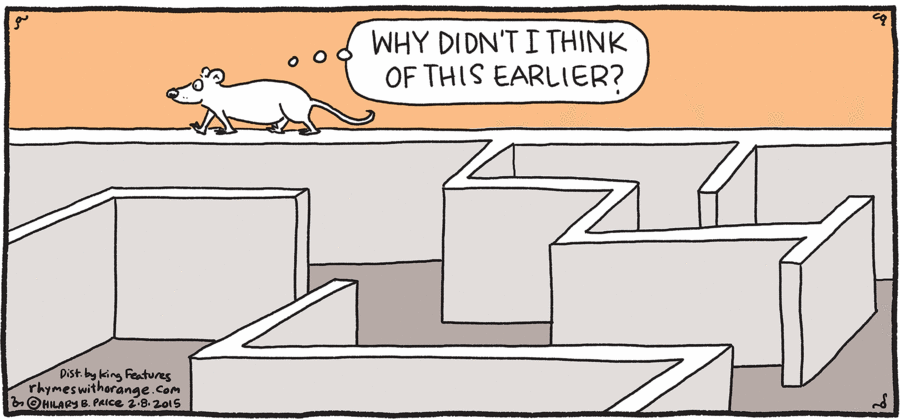
What superpower would you choose: flight, invisibility, or telepathy? Alive, in a sense, the embodiment of the latter has always been the character of the X-Men comic Professor Charles Xavier, who appeared back in 1963 from the pen of Stan Lee. But in the comics and not such superpowers can be found. What about reality? Is it possible to read the thoughts of another being? As it turns out, it is now possible, but not as you imagine. Today we are going to get acquainted with the study, the main achievement of which is reading the electronic activity of neurons in the brain of an experimental rat running through a maze in real time. How did the scientists manage to get into the head of the rat, what did they manage to achieve and what are the prospects for their technology? A research report will give us answers to these and other questions. Go.
The basis of the research
Scientists note that at the moment one of the main tasks in the field of studying the brain as a complex structure is the improvement of methods and relevant tools for collecting and analyzing the data obtained. More precisely, it is important to decipher the information hidden in the collected data on the spatial and temporal activity of neural systems. In other words, the scientists see that something has happened (spike on the chart), you need to get information that corresponds to this event.
According to scientists, it is most difficult to conduct such observations, data collection and analysis in real time. This is done through the NCI (neurocomputer interface), which has multi-electrode sensors.
The most common format for examining the brain through NCI is a cyclical experiment (repeating the same conditions on each attempt). In this case, it is possible to study well certain cognitive functions, like attention, memory and learning.
Spatial navigation is the most famous and most effective method for studying the aforementioned cognitive functions. How does such a test, you ask? Very simple - a labyrinth. During such experiments, the so-called neural coding of space (or “space code”) was discovered in many parts of the rat brain: the hippocampus, the entorhinal cortex, the primary visual cortex (V1), the retrosplenial cortex and the parietal cortex. These "codes" are certain signals that store information about where the rat is in the maze, where it is going and where it is from. It is this information that must be read in real time, and not only after the experiments, when the rat is in a state of rest or sleep (the phase of slow sleep).
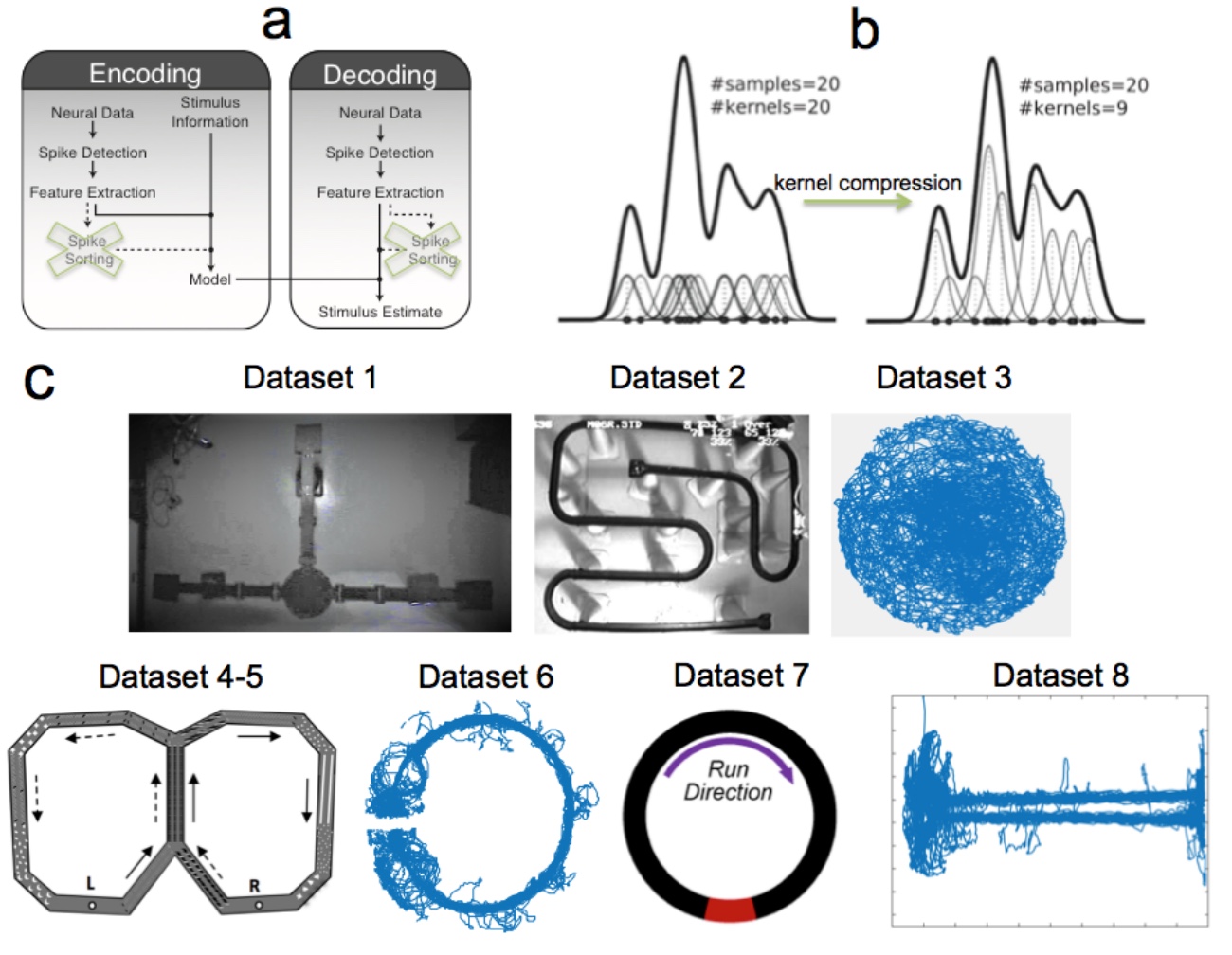
The proposed technique consists of two main stages (schemeAnd on the image above): encoding and decoding. At the stage of coding, the total probability density of the vector of signs of spikes * (neural signal) and spatial position is created. The stage of decoration is responsible for the reconstruction of the data in the form of spatial position, which should correspond to the maximum obtained in the previous stage.
Spike * (Peak) - action potential of neurons during extracellular recording of their electrical activity.From an iron point of view, scientists point out that the problem of analyzing data in real time can be solved using multi-threaded software on a multi-core central processor (hereinafter referred to as the CPU). The drawback of such a system is the number of cores, which limits the scalability of the entire neurocomputer interface system. The researchers decided to implement a graphics processor (GPU) in a conventional quad-core computer. The use of GP greatly accelerates the decoding process and expands the scalability of the system. The sensors themselves were also changed, from tetrodes to high-density silicon sensors.
Research results
During the tests, all variants of the system were tested: on the basis of the CPU, on the basis of the CPU + GP, using tetrodes and silicon sensors. The database consisted of hippocampal, neocortex, and thalamus spikes recorded at the time of spatial navigation in two-dimensional space. Database options are shown in the image above ( C ).
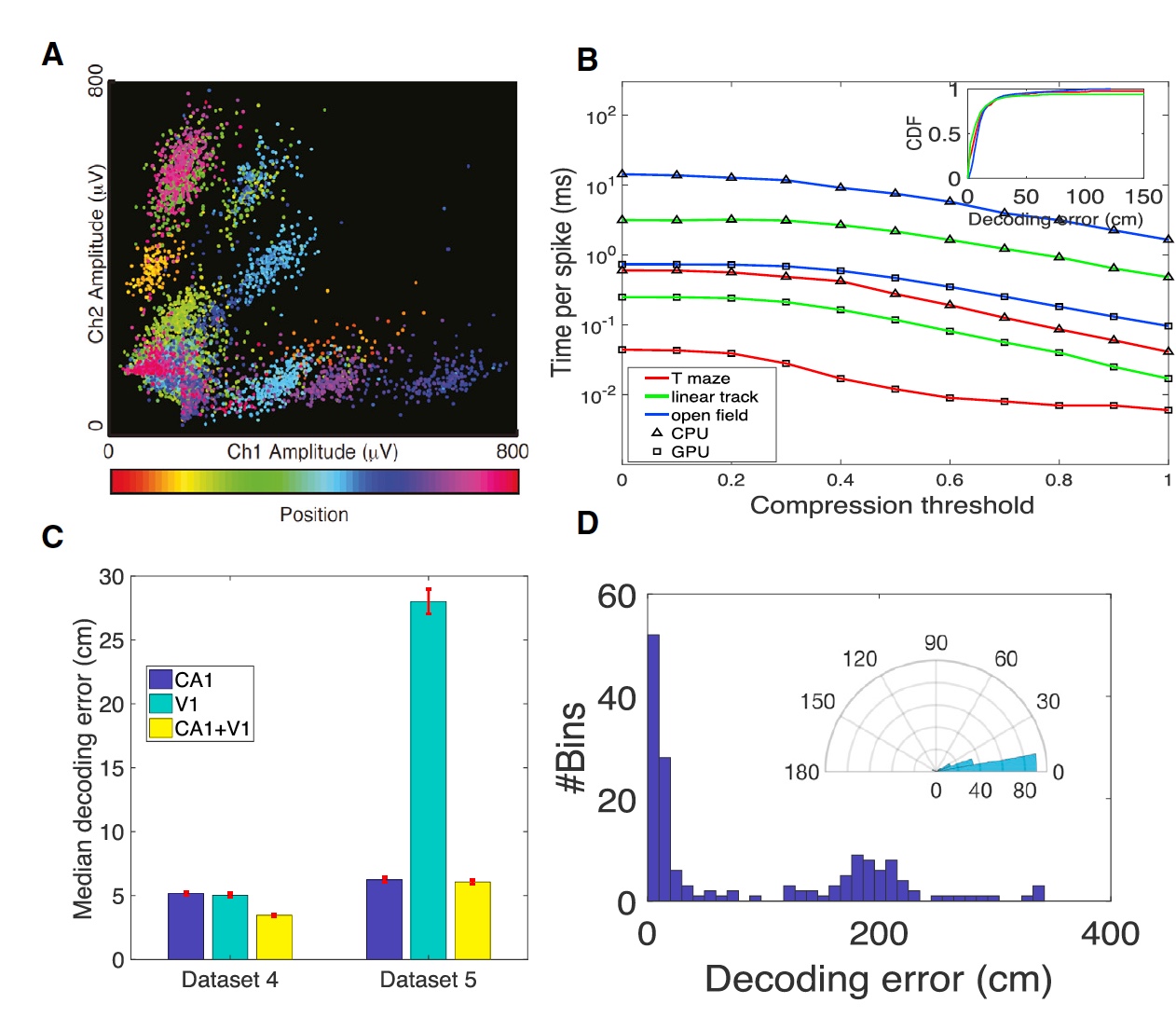
Image No. 1
As scientists expected, a system using a graphics processor showed significantly better results compared to the CPU system.
So, in the case of database No. 1, the system with GP showed a data compression threshold (coding spikes) - 0.5 at a decoding speed of 0.02 ms / spike. Under the same conditions, the CPU showed a decoding speed of 0.44 ms / spike (1V). It is also worth noting that the “gain” of data compression leads to an increase in decoding speed, but also to a decrease in the accuracy of this process.
Also the core throughput plays an important role in the decoding process. If this parameter was small, then the compression ratio affected the decoding accuracy slightly.
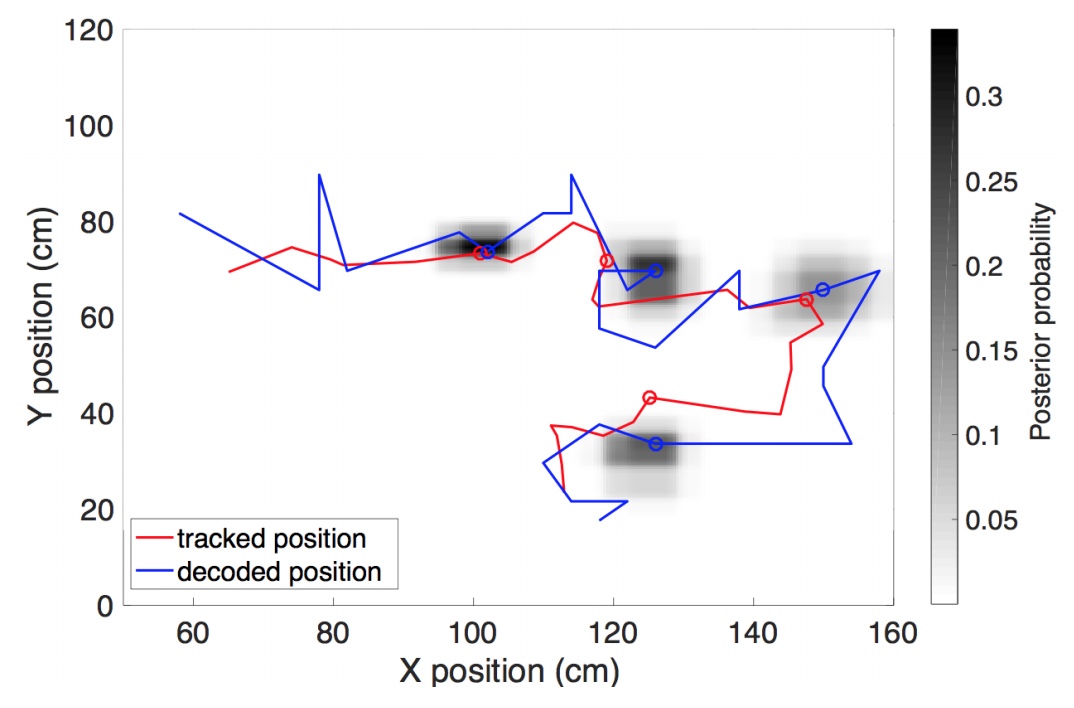
Graph of the accuracy of the decoded data in comparison with the real.
In addition to excellent data decoding speed, scientists also boast a high degree of decoding accuracy.
Next, the researchers conducted an experiment in which the rat was supposed to move through the labyrinth in the form of a figure eight, and the tetrodes read indicators not only of the CA1 section of the hippocampus, but also of the primary visual cortex V1.
The decoration was carried out in a mixed format: separately CA1, separately V1 and CA1 + V1. Analysis of the V1 data showed that the spikes of this area contain an impressive amount of information regarding spatial displacement. By combining V1 data with CA1 data, scientists were able to improve the overall decoding accuracy ( 1C ).
The parameters of the nucleus were optimized for each part of the brain (CA1 and V1) separately, based on cross-checking data. The decoding accuracy was high. And with zero data compression, as expected, the decoding speed was very low.
The following experiment was carried out in a labyrinth, which is difficult to call such, given its appearance - a simple ring. The rat ran in circles, and the tetrodes read the data of the anterior nucleus of the thalamus. This area of the brain is one of the most important in the process of memory formation and spatial orientation.
The important point is that most of the neurons of the anterior nucleus of the thalamus are head direction neurons. Therefore, in the process of analyzing the data, not only the activity of the brain lobes corresponding to the position of the body, but also the position of the head was taken into account, for these two parameters may differ.
Analysis of the activity of the neurons of the anterior nucleus of the thalamus confirmed its attitude not only to the position of the head, but also to the spatial orientation of the subject during the tests. However, in the case of a circular test, a decrease in decoding accuracy of head position data was observed, which is not related to the speed of movement of the rat. This is due to the direction of movement. More precisely, the calculations took into account both versions - clockwise and counterclockwise.
This test (running in a circle) is not important trajectory of motion and not the complexity of the maze (and in fact it is not there, just a ring). An important factor here is the speed of movement of the rat. While running, the activity of neurons also accelerates, thereby overseeing the movement of the rat. A system using a graphics processor was able to decode the hippocampal neuronal spikes much faster (with fewer training attempts) than a conventional system based only on the CPU.
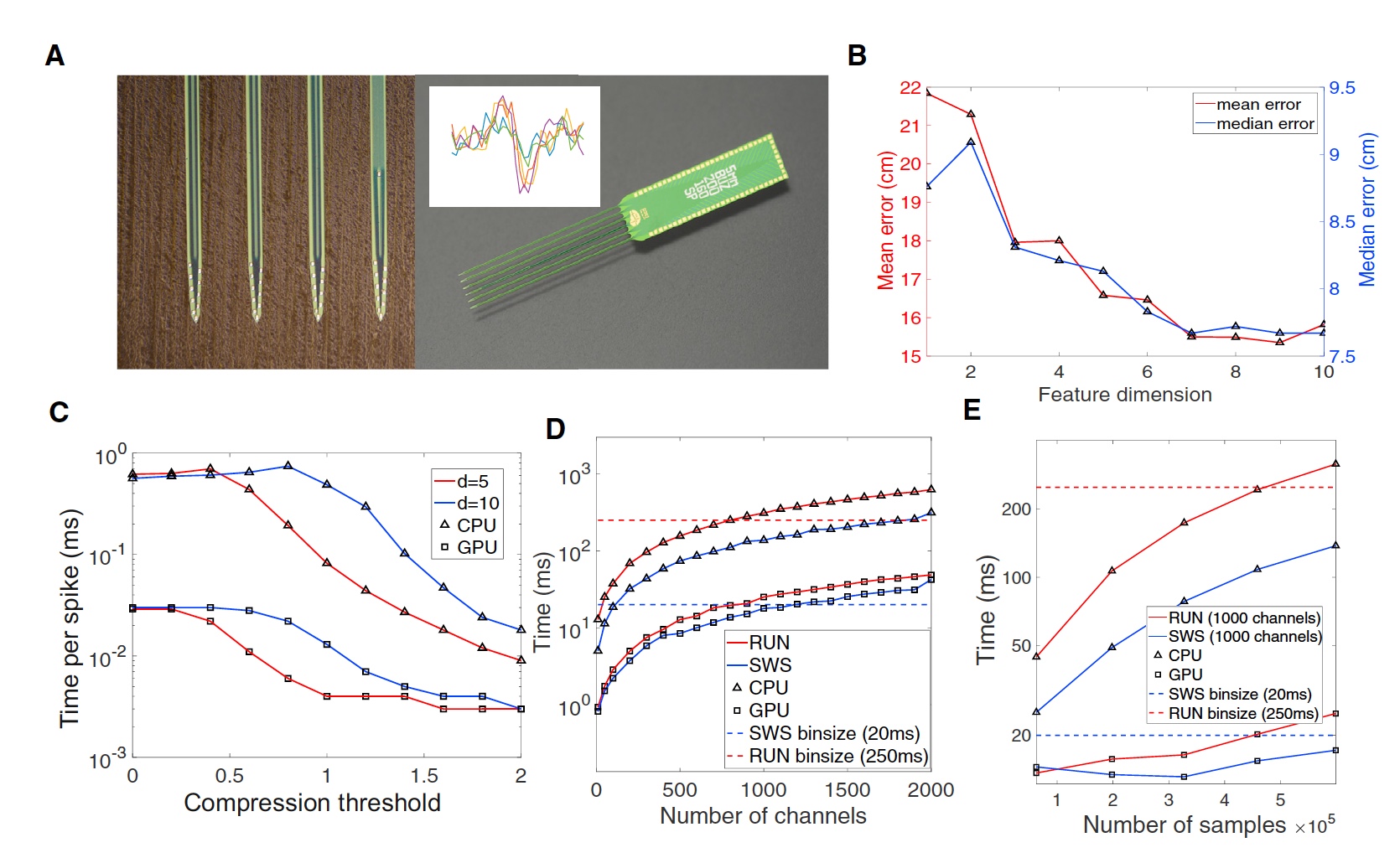
Image No. 2
Tetrodes used in the experiments made it possible to obtain fairly accurate data, but this is not the limit of what is desired. Therefore, it was decided to check also silicon multichannel electrodes. Figure 2A shows a 64-channel silicon electrode. Two of these sensors were located in the left and right hippocampus.
It was also necessary to check how much the system was scaled. To do this, the data of silicon electrodes were “cloned” until the number of hypothetical channels reached 2000. Next, the system had to decode this data during the period of movement (running) and rest (the phase of slow sleep). The results are shown in a 2D graph .
The optimization of the GPU and the use of direct memory access allowed us to achieve the following indicators: the time to decode during the period of motion is 250 ms, the time to decode to the period of rest is 20 ms. In the second case, data compression was not carried out at the coding stage, and about 1200 channels were involved in total.
Chart 2Eindicates that the time required for decoding with a fixed number of channels increases dramatically if the system uses only the CPU. The slowdown of the decoding process when using a graphics processor is not so significant and does not happen so dramatically.
An important feature of this study is the reading and processing of neuron activity data in real time. For this, a system with GP is ideal, since it can decode a large amount of data in a very short period of time, as previous tests have shown.
To test the system, decoding of the hippocampus activity was performed during the slow sleep phase (741 reproduction of possible memory events).
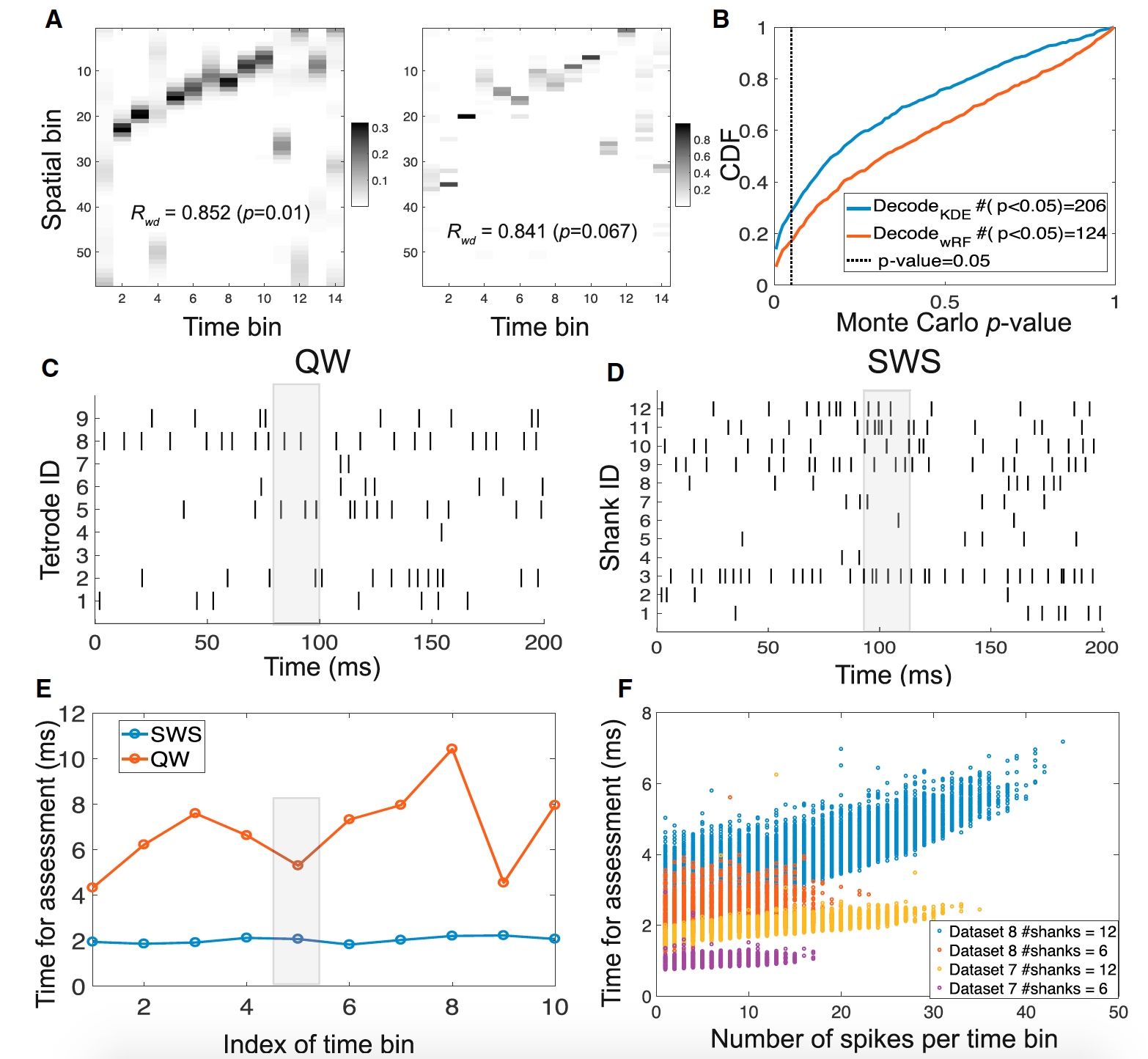
Image number 3
Comparison of standard methods for analyzing data after testing and real-time techniques, scientists found an increase in the accuracy of reconstruction (during slow sleep) of the rat's movement trajectory. That is, the system more accurately reconstructed the trajectory along which the rat moved during the test. At the same time, the system analyzed the activity of neurons already after the test, during the rest period (the phase of slow sleep).
For more detailed acquaintance with this study, I strongly recommend to look into the report of scientists and additional materials to it.
Epilogue
This study first of all confirmed that reading of neuron activity in real time is possible. When it comes to such a complex system as nervous, any delay in the analysis of its activities greatly reduces the accuracy of the data obtained. Therefore, this study is of such importance.
With the help of their methodology, scientists were able not only to build a route of movement for the rat, relying solely on brain activity, but also to reconstruct this route using the memory of the test animal. This is really incredible, damn difficult and uniquely promising.
Further improvement of the system will allow analyzing data with greater accuracy and speed, which will allow understanding the principles of the brain, interconnection of neurons with each other, their reactions to external factors and compare certain events occurring with the body with the activity of certain neurons, and not parts of the brain as a whole.
The brain is still one of the most neglected systems in the world. However, the efforts of scientists whose imagination to create new methods of studying it is truly limitless, we can understand more. And the more we know about the work of the brain, the better we will be able to influence it. In a good sense, of course: diagnosis of diseases in the early stages, treatment of advanced brain diseases, etc. In this case, knowledge is not only strength, but also health.
And, of course, Friday offtop:
Реклама из категории «забавно, но странно», особенно учитывая продукт, который рекламируется :)
Спасибо за внимание, оставайтесь любопытствующими и берегите здоровье. Хороших выходных, ребята.
Реклама из категории «забавно, но странно», особенно учитывая продукт, который рекламируется :)
Спасибо за внимание, оставайтесь любопытствующими и берегите здоровье. Хороших выходных, ребята.
Thank you for staying with us. Do you like our articles? Want to see more interesting materials? Support us by placing an order or recommending to friends, 30% discount for Habr's users on a unique analogue of the entry-level servers that we invented for you: The whole truth about VPS (KVM) E5-2650 v4 (6 Cores) 10GB DDR4 240GB SSD 1Gbps from $ 20 or how to share the server? (Options are available with RAID1 and RAID10, up to 24 cores and up to 40GB DDR4).
VPS (KVM) E5-2650 v4 (6 Cores) 10GB DDR4 240GB SSD 1Gbps until January 1 for free if you pay for a period of six months, you can order here .
Dell R730xd 2 times cheaper? Only we have 2 x Intel Dodeca-Core Xeon E5-2650v4 128GB DDR4 6x480GB SSD 1Gbps 100 TV from $ 249in the Netherlands and the USA! Read about How to build an infrastructure building. class c using servers Dell R730xd E5-2650 v4 worth 9000 euros for a penny?
